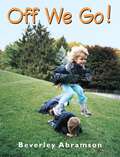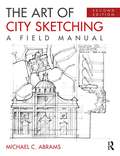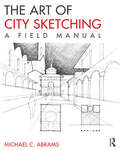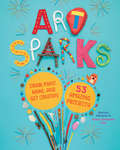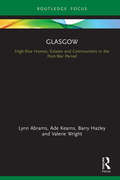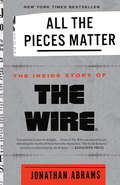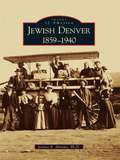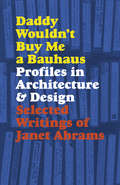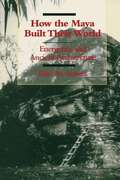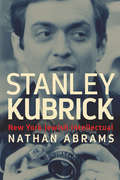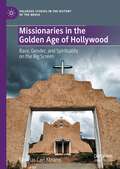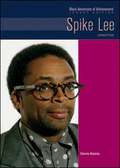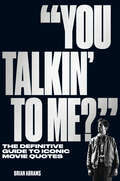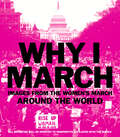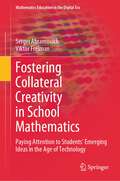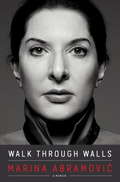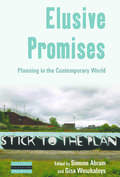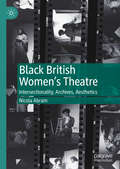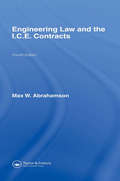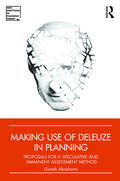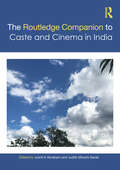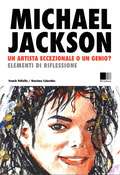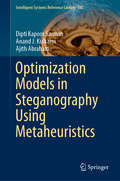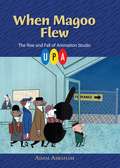- Table View
- List View
Off We Go!
by Beverley AbramsonThe natural state of toddlers and young children is motion, and Beverley Abramson’s splendid photographs are an appreciation of the many ways in which we can move. Children spin and whirl, run, jump, and climb through the seasons in photographs that beg for discussion and storytelling.Whether it is flying a kite or kicking a ball, skipping on the grass or riding a tricycle, Beverley Abramson has captured kids experiencing the sheer pleasure of exploring the world through movement. Best of all, it is an invitation to get children to discover the fun of physical play.
The Art of City Sketching: A Field Manual
by Michael C. AbramsThe Art of City Sketching: A Field Manual guides readers through the process of freehand architectural sketching and explains orthographic, diagrammatic, three-dimensional, and perceptual-type drawings. The book presents hundreds of drawings of historic buildings and urban spaces, examples, and exercises, which help readers develop their drawing skills and employ sketching as an analytical tool. The book is divided into three parts, based on the reader’s skill level: beginner, intermediate, and advanced. As an architect and field sketching instructor, the author shows that through drawing the reader can discover, analyze, and comprehend the built environment. The new edition of The Art of City Sketching expands on the drawing techniques of the previous version by adding new drawing examples, exercises, and two new chapters—Chiaroscuro and Storyboard. New drawing tips, demonstrations, and composition "do’s and don’ts" will support readers when they illustrate their viewpoint of the city by using simple drawing tools. The lessons in this book will allow readers to mix method with imagination and sensibility.
The Art of City Sketching: A Field Manual
by Michael AbramsThe Art of City Sketching: A Field Manual guides you through the laborious and sometimes complex process of sketching what you see in the built environment so that you can learn to draw what you imagine. Illustrated with hundreds of drawings by students and professionals of cityscapes around Europe and the United States, the book helps you develop your conceptual drawing skills so that you can communicate graphically to represent the built environment. Short exercises, projects, drawing tips, step-by-step demonstrations, and composition do's and don'ts make it easy for you to get out into the city and experiment in your own work. Author Michael Abrams uses his experience as a field sketching instructor, to show you that by drawing, you can discover, analyze, and comprehend the built environment.
Art Sparks: Draw, Paint, Make, and Get Creative with 53 Amazing Projects!
by Marion Abrams Hilary Emerson LayEvery kid can be an artist with this book as their guide! Using basic art supplies — from paint, markers, paper, and glue to household finds like cardboard boxes and fabric scraps — children aged 6 and up learn that as long as they can imagine it, they can create it. Curated by two art educators with decades of experience, this rich collection of 53 arts and crafts activities offers up a ton of freeform fun, from Doodlemonsters and Painted Animal Rocks to Paper Bead Jewelry and Nature Weaving. Projects vary in difficulty so there’s something for a wide range of ages and abilities, and many can be completed in under an hour. Each project featured in the book has been kid-made (and kid-approved!), and colorful photos of the finished pieces will ignite a creative spark that inspires budding makers to express their imagination, humor, and individuality through art. This publication conforms to the EPUB Accessibility specification at WCAG 2.0 Level AA.
Glasgow: High-Rise Homes, Estates and Communities in the Post-War Period (Built Environment City Studies)
by Lynn Abrams Ade Kearns Barry Hazley Valerie WrightIn the wake of an unparalleled housing crisis at the end of the Second World War, Glasgow Corporation rehoused the tens of thousands of private tenants who were living in overcrowded and unsanitary conditions in unimproved Victorian slums. Adopting the designs, the materials and the technologies of modernity they built into the sky, developing high-rise estates on vacant sites within the city and on its periphery. This book uniquely focuses on the people's experience of this modern approach to housing, drawing on oral histories and archival materials to reflect on the long-term narrative and significance of high-rise homes in the cityscape. It positions them as places of identity formation, intimacy and well-being. With discussions on interior design and consumption, gender roles, children, the elderly, privacy, isolation, social networks and nuisance, Glasgow examines the connections between architectural design, planning decisions and housing experience to offer some timely and prescient observations on the success and failure of this very modern housing solution at a moment when high flats are simultaneously denigrated in the social housing sector while being built afresh in the private sector. Glasgow is aimed at an academic readership, including postgraduate students, scholars and researchers. It will be of interest to social, cultural and urban historians particularly interested in the United Kingdom.
All the Pieces Matter: The Inside Story of The Wire®
by Jonathan Abrams<P>The definitive oral history of the iconic and beloved TV show The Wire, as told by the actors, writers, directors, and others involved in its creation. <P>Since its final episode aired in 2008, HBO's acclaimed crime drama The Wire has only become more popular and influential. The issues it tackled, from the failures of the drug war and criminal justice system to systemic bias in law enforcement and other social institutions, have become more urgent and central to the national conversation. <P>The show's actors, such as Idris Elba, Dominic West, and Michael B. Jordan, have gone on to become major stars. Its creators and writers, including David Simon and Richard Price, have developed dedicated cult followings of their own. Universities use the show to teach everything from film theory to criminal justice to sociology. Politicians and activists reference it when discussing policy. When critics compile lists of the Greatest TV Shows of All Time, The Wire routinely takes the top spot. It is arguably one of the great works of art America has produced in the 20th century. <P>But while there has been a great deal of critical analysis of the show and its themes, until now there has never been a definitive, behind-the-scenes take on how it came to be made. With unparalleled access to all the key actors and writers involved in its creation, Jonathan Abrams tells the astonishing, compelling, and complete account of The Wire, from its inception and creation through its end and powerful legacy. <P><b>A New York Times Bestseller</b>
Jewish Denver: 1859-1940 (Images of America)
by Jeanne E. AbramsIn 1859, during the Pike's Peak gold rush, at least 12 Jews joined the great migration to Colorado in search of gold and a brighter future. The unpredictability of mining and a growing demand for supplies encouraged many of these Jewish settlers to establish small businesses in Denver and in towns and mining camps across the state. By the early 1870s, Jewish benevolent societies and a congregation were established. Denver's dry, mild climate attracted patients with tuberculosis, and two Jewish sanatoriums were opened in the city around the beginning of the 20th century. Many of the predominantly Eastern European Jews who came in search of better health made Denver their home, thus augmenting the early Jewish population significantly. Today Jewish life flourishes in Colorado, and Jewish citizens continue to play a vital role in its culture and development.
Daddy Wouldn't Buy Me a Bauhaus: Profiles in Architecture and Design
by Janet AbramsDaddy Wouldn't Buy Me a Bauhaus collects the unparalleled writings of legendary British wordsmith Janet Abrams for the first time. From pivotal figures in international modernism to the pioneers of digital medium, Abrams explored the ideas, theories, and emotions that fueled their work.The book's twenty-six profiles, written in Abrams's signature, personal, often hilarious style, include Reyner Banham, Berthold Lubetkin, Philip Johnson, Paul Rand, Phyllis Lambert, Frank Gehry, Rem Koolhaas, Muriel Cooper, April Greiman, and Michael Bloomberg. Many of the profiles are back in print for the first time, having originally appeared in Blueprint, I.D. magazine, the Independent, and in books and catalogs from the 1980s through the early 2000s. A foreword by Blueprint's founding editor, Deyan Sudjic, and new reflections by Abrams set the stage.
How the Maya Built Their World
by Elliot M. AbramsMaya architecture is often described as "massive" and "monumental," but experiments at Copan, Honduras, convinced Elliot Abrams that 300 people could have built one of the large palaces there in only 100 days. In this groundbreaking work, Abrams explicates his theory of architectural energetics, which involves translating structures into volumes of raw and manufactured materials that are then multiplied by the time required for their production and assembly to determine the labor costs of past construction efforts. Applying this method to residential structures of the Late Classic period (A. D. 700-900) at Copan leads Abrams to posit a six-tiered hierarchic social structure of political decision making, ranging from a stratified elite to low-ranking commoners. By comparing the labor costs of construction and other economic activities, he also prompts a reconsideration of the effects of royal construction demands on commoners.
Stanley Kubrick: New York Jewish Intellectual
by Dr Nathan AbramsStanley Kubrick is generally acknowledged as one of the world’s great directors. Yet few critics or scholars have considered how he emerged from a unique and vibrant cultural milieu: the New York Jewish intelligentsia. Stanley Kubrick reexamines the director’s work in context of his ethnic and cultural origins. Focusing on several of Kubrick’s key themes—including masculinity, ethical responsibility, and the nature of evil—it demonstrates how his films were in conversation with contemporary New York Jewish intellectuals who grappled with the same concerns. At the same time, it explores Kubrick’s fraught relationship with his Jewish identity and his reluctance to be pegged as an ethnic director, manifest in his removal of Jewish references and characters from stories he adapted. As he digs deep into rare Kubrick archives to reveal insights about the director’s life and times, film scholar Nathan Abrams also provides a nuanced account of Kubrick’s cinematic artistry. Each chapter offers a detailed analysis of one of Kubrick’s major films, including Lolita, Dr. Strangelove, 2001, A Clockwork Orange, Barry Lyndon, The Shining, Full Metal Jacket, and Eyes Wide Shut. Stanley Kubrick thus presents an illuminating look at one of the twentieth century’s most renowned and yet misunderstood directors.
Missionaries in the Golden Age of Hollywood: Race, Gender, and Spirituality on the Big Screen (Palgrave Studies in the History of the Media)
by Douglas Carl AbramsThis book examines major British and American missionary films during the Golden Age of Hollywood to explore the significance of race, gender, and spirituality in relation to the lives of the missionaries portrayed in film during the middle third of the twentieth century. Film both influences and reflects culture, and racial, gender, and religious identities are some of the most debated issues globally today. In the movies explored in this book, missionary interactions with various people groups reflect the historical changes which took place during this time.
Spike Lee (Black Americans of Achievement--Legacy Edition)
by Dennis AbramsIn his own words, Spike Lee is the man who single-handedly "broke the color barrier" in Hollywood in the mid 1980s. In a film career that spans more than 20 years, Lee has established himself as one of the United States' premier filmmakers, a director whose films explore the many aspects of the African-American experience. Never one to shy away from controversy--he has been accused of racism, anti-Semitism, and sexism--Lee uses film to raise tough questions and to provoke discussion. How was he able to break down the doors of Hollywood for himself and for other African-American directors, actors, and technicians? How has he continued to grow and develop as a filmmaker? Spike Lee presents a nuanced portrait of an artist who has become a symbol of contemporary American culture.
"You Talkin' to Me?": The Definitive Guide to Iconic Movie Quotes
by Brian AbramsThis deep dive into hundreds of Hollywood&’s most iconic and beloved lines is a must-have for every film buff."You Talkin&’ to Me?" is a fun, fascinating, and exhaustively reported look at all the iconic Hollywood movie quotes we know and love, from Casablanca to Dirty Harry and The Godfather to Mean Girls. Drawing on interviews, archival sleuthing, and behind-the-scenes details, the book examines the origins and deeper meanings of hundreds of film lines: how they&’ve impacted, shaped, and reverberated through the culture, defined eras in Hollywood, and become cemented in the modern lexicon. Packed with film stills, sidebars, lists, and other fun detours throughout movie history, the book covers all genres and a diverse range of directors, writers, and audiences.
Why I March: Images from The Women's March Around the World
by Abrams BooksAn inspiring photographic account of the worldwide Women’s March of 2017—one of the biggest peaceful protests in history.On January 21, 2017, five million people in eighty-two countries and on all seven continents stood up with one voice. The Women’s March began with one cause, women’s rights, but quickly became a movement around the many issues that were hotly debated during the 2016 U.S. presidential race—immigration, health care, environmental protections, LGBTQ rights, racial justice, freedom of religion, and workers’ rights, among others. In the mere sixty-six days between the election and inauguration of Donald J. Trump as the 45th President of the United States, 673 sister marches sprang up across the country and the world. Why I March documents and honors the movement, gives back to it—and inspires future activism in the same vein.All royalties from the sale of this book will be donated to nonprofit organizations affiliated with the March.
Fostering Collateral Creativity in School Mathematics: Paying Attention to Students’ Emerging Ideas in the Age of Technology (Mathematics Education in the Digital Era #23)
by Sergei Abramovich Viktor FreimanThis book explores the topic of using technology, both physical and digital, to motivate creative mathematical thinking among students who are not considered ‘mathematically advanced.’ The book reflects the authors’ experience of teaching mathematics to Canadian and American teacher candidates and supervising several field-based activities by the candidates. It consists of eight chapters and an Appendix which includes details of constructing computational learning environments.Specifically, the book demonstrates how the appropriate use of technology in the teaching of mathematics can create conditions for the emergence of what may be called ‘collateral creativity,’ a notion similar to Dewey’s notion of collateral learning. Just as collateral learning does not result from the immediate goal of the traditional curriculum, collateral creativity does not result from the immediate goal of traditional problem solving. Rather, mathematical creativity emerges as a collateral outcome of thinking afforded by the use of technology. Furthermore, collateral creativity is an educative outcome of one’s learning experience with pedagogy that motivates students to ask questions about computer-generated or tactile-derived information and assists them in finding answers to their own or the teacher’s questions. This book intends to provide guidance to teachers for fostering collateral creativity in their classrooms.
Walk Through Walls: A Memoir
by Marina Abramovic"I had experienced absolute freedom--I had felt that my body was without boundaries, limitless; that pain didn't matter, that nothing mattered at all--and it intoxicated me."In 2010, more than 750,000 people stood in line at Marina Abramović's MoMA retrospective for the chance to sit across from her and communicate with her nonverbally in an unprecedented durational performance that lasted more than 700 hours. This celebration of nearly fifty years of groundbreaking performance art demonstrated once again that Marina Abramović is truly a force of nature. The child of Communist war-hero parents under Tito's regime in postwar Yugoslavia, she was raised with a relentless work ethic. Even as she was beginning to build an international artistic career, Marina lived at home under her mother's abusive control, strictly obeying a 10 p.m. curfew. But nothing could quell her insatiable curiosity, her desire to connect with people, or her distinctly Balkan sense of humor--all of which informs her art and her life. The beating heart of Walk Through Walls is an operatic love story--a twelve-year collaboration with fellow performance artist Ulay, much of which was spent penniless in a van traveling across Europe--a relationship that began to unravel and came to a dramatic end atop the Great Wall of China. Marina's story, by turns moving, epic, and dryly funny, informs an incomparable artistic career that involves pushing her body past the limits of fear, pain, exhaustion, and danger in an uncompromising quest for emotional and spiritual transformation. A remarkable work of performance in its own right, Walk Through Walls is a vivid and powerful rendering of the unparalleled life of an extraordinary artist.From the Hardcover edition.
Walk Through Walls: A Memoir
by Marina Abramovic"I had experienced absolute freedom--I had felt that my body was without boundaries, limitless; that pain didn't matter, that nothing mattered at all--and it intoxicated me."In 2010, more than 750,000 people stood in line at Marina Abramović's MoMA retrospective for the chance to sit across from her and communicate with her nonverbally in an unprecedented durational performance that lasted more than 700 hours. This celebration of nearly fifty years of groundbreaking performance art demonstrated once again that Marina Abramović is truly a force of nature. The child of Communist war-hero parents under Tito's regime in postwar Yugoslavia, she was raised with a relentless work ethic. Even as she was beginning to build an international artistic career, Marina lived at home under her mother's abusive control, strictly obeying a 10 p.m. curfew. But nothing could quell her insatiable curiosity, her desire to connect with people, or her distinctly Balkan sense of humor--all of which informs her art and her life. The beating heart of Walk Through Walls is an operatic love story--a twelve-year collaboration with fellow performance artist Ulay, much of which was spent penniless in a van traveling across Europe--a relationship that began to unravel and came to a dramatic end atop the Great Wall of China. Marina's story, by turns moving, epic, and dryly funny, informs an incomparable artistic career that involves pushing her body past the limits of fear, pain, exhaustion, and danger in an uncompromising quest for emotional and spiritual transformation. A remarkable work of performance in its own right, Walk Through Walls is a vivid and powerful rendering of the unparalleled life of an extraordinary artist.From the Hardcover edition.
Elusive Promises
by Simone Abram Gisa WeszkalnysPlanning in contemporary democratic states is often understood as a range of activities, from housing to urban design, regional development to economic planning. This volume sees planning differently-as the negotiation of possibilities that time offers space. It explores what kind of promise planning offers, how such a promise is made, and what happens to it through time. The authors, all leading anthropologists, examine the time and space, creativity and agency, authority and responsibility, and conflicting desires that plans attempt to control. They show how the many people involved with planning deal with the discrepancies between what is promised and what is done. The comparative essays offer insight into the expected and unexpected outcomes of planning (from visionary utopias to bureaucratic dystopia or something in-between), how the future is envisioned at the outset, and what actual work is done and how it affects people's lives.
Black British Women's Theatre: Intersectionality, Archives, Aesthetics
by Nicola AbramThis book marks a significant methodological shift in studies of black British women’s theatre: it looks beyond published plays to the wealth of material held in archives of various kinds, from national repositories and themed collections to individuals’ personal papers. It finds there a cache of unpublished manuscripts and production recordings distinctive for their non-naturalistic aesthetics. Close analysis of selected works identifies this as an intersectional feminist creative practice. Chapters focus on five theatre companies and artists, spanning several decades: Theatre of Black Women (1982-1988), co-founded by Booker Prize-winning writer Bernardine Evaristo; Munirah Theatre Company (1983-1991); Black Mime Theatre Women’s Troop (1990-1992); Zindika; and SuAndi. The book concludes by reflecting on the politics of representation, with reference to popular postmillennial playwright debbie tucker green. Drawing on new interviews with the playwrights/practitioners and their peers, this book assembles a rich, interconnected, and occasionally corrective history of black British women’s creativity. By reproducing 22 facsimile images of flyers, production programmes, photographs and other ephemera, Black British Women’s Theatre: Intersectionality, Archives, Aesthetics not only articulates a hidden history but allows its readers their own encounter with the fragile record of this vibrant past.
Engineering Law and the I.C.E. Contracts
by M.W. AbrahamsonThe forms of tender, agreement, conditions and bond published by the Institution of Civil Engineers have been designed to standardise the duties of contractors, employers and engineers and to distribute fairly the risks inherent in civil engineering.This classic guide to the contracts provides and authoritative reference, and also a rich and practi
Making Use of Deleuze in Planning: Proposals for a speculative and immanent assessment method (New Directions in Planning Theory)
by Gareth AbrahamsMaking Use of Deleuze in Planning translates and re-creates some of Gilles Deleuze’s most abstract philosophical concepts to form a new, practicable planning assessment tool. It shows what his philosophy can do for planning theory as well as planning assessment practice and, in doing so, sets out a pragmatic approach to Deleuzian studies: one that helps form bridges between ontological problems and the problems found in professional practice. It also breaks new ground in assessment methodology by challenging the essentialist ideas underpinning assessment methods like BREEAM and setting out and testing a new form of non-essentialist assessment named SIAM. The book argues that Deleuze’s philosophy can be made useful to planning as long as one is prepared to adapt and re-create his key ontological concepts to respond to the specific demands of the field.
The Routledge Companion to Caste and Cinema in India
by Joshil K. Abraham Judith Misrahi-BarakThis companion is the first study of caste and its representation in Indian cinema. It unravels the multiple layers of caste that feature directly and indirectly in Indian movies, to examine not only the many ways caste pervades Indian society and culture but also how the struggle against it adopts multiple strategies. The companion: • critiques Indian cinema production through the lens of anti-caste discourse; • traces the history of films beginning from the early twentieth century, focusing on caste representations across India, including Hindi, Malayalam, Kannada, Marathi, Bengali, Punjabi, Tamil as well as silent films; • makes a foray into OTT media; • includes analysis of popular films such as Padmaavat, Masaan, Fandry, Sairat, Sujata, Article 15, Chomana Dudi, Lagaan, Court, Ee.Ma.Yau, Kaala, Pariyerum Perumal, Perariyathavar, among many others, to critique and problematise the idea of caste. A major intervention, this book alters traditional approaches to ‘caste’ in Indian cinemas and society and explores new political strategies implemented through cinematic creation and aesthetics. It will be indispensable for scholars and researchers of film studies, social discrimination and exclusion studies, human rights, popular culture, and South Asian studies. It will also be of interest to enthusiasts of Indian cinematic history.
Michael Jackson: un Artista eccezionale, o un Genio? Elementi di riflessione.
by David Abraham Franck VidiellaAnalizzando la carriera di Michael Jackson, Franck Vidiella mette in dubbio la natura sensitiva del termine di "Genio". Basata su una ricerca che conferma il fatto che i grandi genii sono, quasi totalmente, creativi, brillanti, ostinati e pluri-faccettati, ognuna delle tematiche viene analizzata studiando la carriera della Pop Star, in modo tale da offrire elementi per rispondere alla seguente domanda: Era Michael Jackson un'artista eccezionale o un Genio assoluto? La risposta, come potrete vedere, permette un dibattito appassionato.
Optimization Models in Steganography Using Metaheuristics (Intelligent Systems Reference Library #187)
by Ajith Abraham Anand J. Kulkarni Dipti Kapoor SarmahThis book explores the use of a socio-inspired optimization algorithm (the Cohort Intelligence algorithm), along with Cognitive Computing and a Multi-Random Start Local Search optimization algorithm. One of the most important types of media used for steganography is the JPEG image. Considering four important aspects of steganography techniques – picture quality, high data-hiding capacity, secret text security and computational time – the book provides extensive information on four novel image-based steganography approaches that employ JPEG compression. Academics, scientists and engineers engaged in research, development and application of steganography techniques, optimization and data analytics will find the book’s comprehensive coverage an invaluable resource.
When Magoo Flew
by Adam AbrahamWhat do Franklin Roosevelt, Dr. Seuss, the U.S. Navy, and Mr. Magoo have in common? They are all part of the surprising story of the pioneering cartoon studio UPA (United Productions of America). Throughout the 1950s, a group of artists ran a business that broke all the rules, pushing animated films beyond the fluffy fantasy of the Walt Disney Studio and the crash-bang anarchy of Warner Bros. Instead, UPA's films were innovative and graphically bold--the cartoon equivalent to modern art. When Magoo Flew is the first book-length study to chronicle the complete story of this unique American enterprise. The book features cameo appearances by Aldous Huxley, James Thurber, Orson Welles, Judy Garland, Robert Goulet, Jim Backus, Eddie Albert, and Woody Allen, as well as a select filmography of the best of UPA.Ebook Edition Note: The ebook has three images redacted: figures 1, 2, and 51.
